Wild Foraging: How To Identify, Harvest and Prepare Bracken Fern (Fiddleheads)
This post may contain affiliate links. See my disclosure policy.
Bracken fern is an edible plant found in the wild with a unique and tasty flavor profile. It’s grows in abundance in a variety of terrains. Learn where to find it, how to identify it, and how to prepare it for eating.
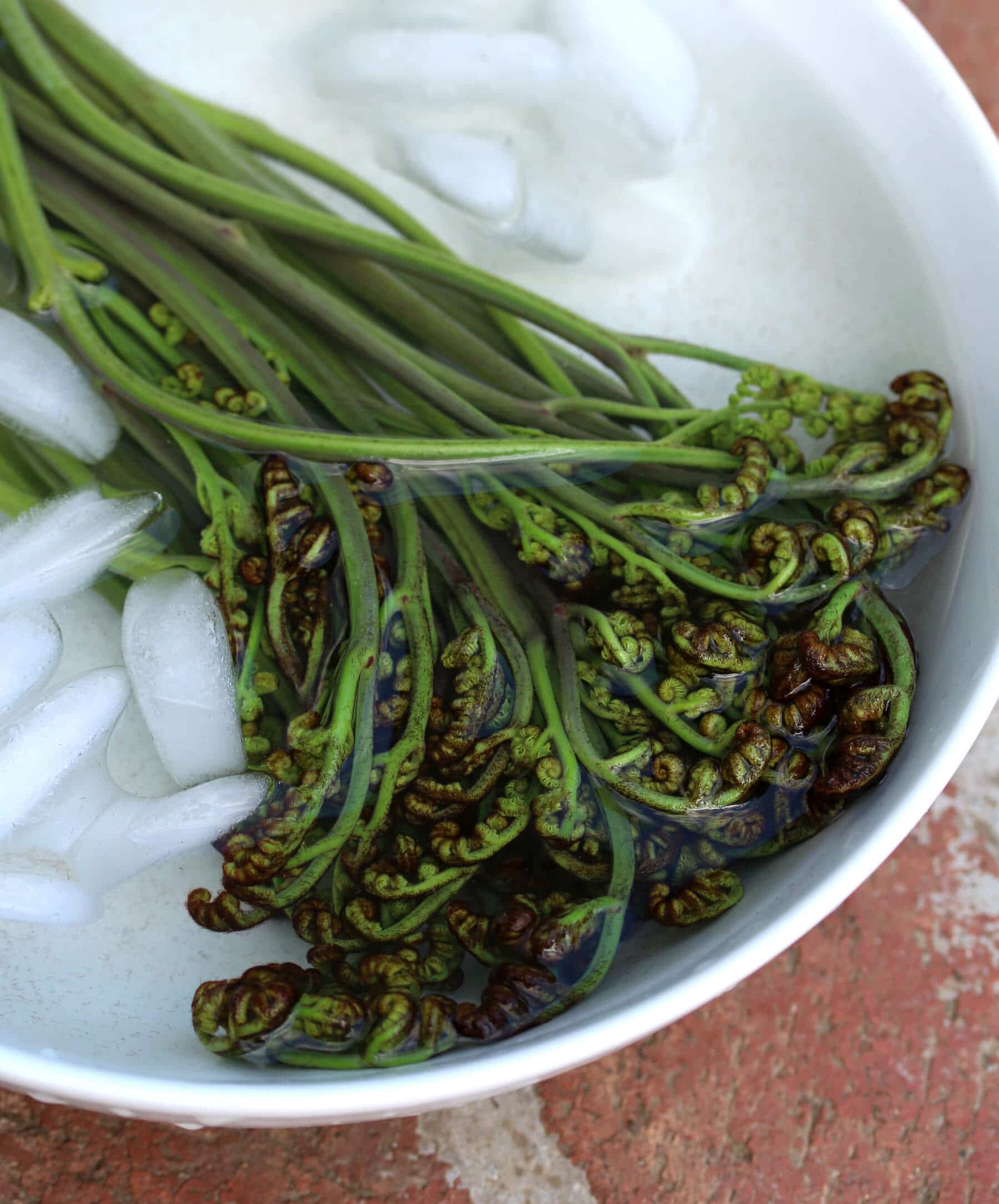
What is Bracken Fern?
It tastes like asparagus and almonds you can pick it wild on hillsides, open pastures, burned-over areas, in woodlands and other shaded places. It’s pretty much everywhere! The young immature fronds of bracken ferns are known as fiddleheads and were widely consumed by Native Americans in the U.S. for centuries as well as in other regions of the world. They are still consumed by millions throughout the world today, are considered more of a delicacy in the U.S.now, but are very popular and commonly in Japan and Korea.
Bracken ferns are thought to have the widest distribution of any fern in the world, are most prolific herbaceous plant in North America, with the exception of Antarctica, are found on every continent and in every environment except for deserts. They’re also one of the oldest ferns in the world with fossil records going back 55 million years.

How to Identify Bracken Fern
Bracken has large, triangular-shaped fronds and is the only fern with side branches. It’s bright green in the Spring and then in late Summer the leaves turn golden and then brown. The fern never completely dies but remains in this “dead stage” through the winter and then new shoots come up the next Spring where the old growth is.
You can identify these new young edible shoots as single un-branched stalks with fronds coming off the stem at intervals. The very top, the fiddlehead, is curled up and will gradually unroll as it grows.
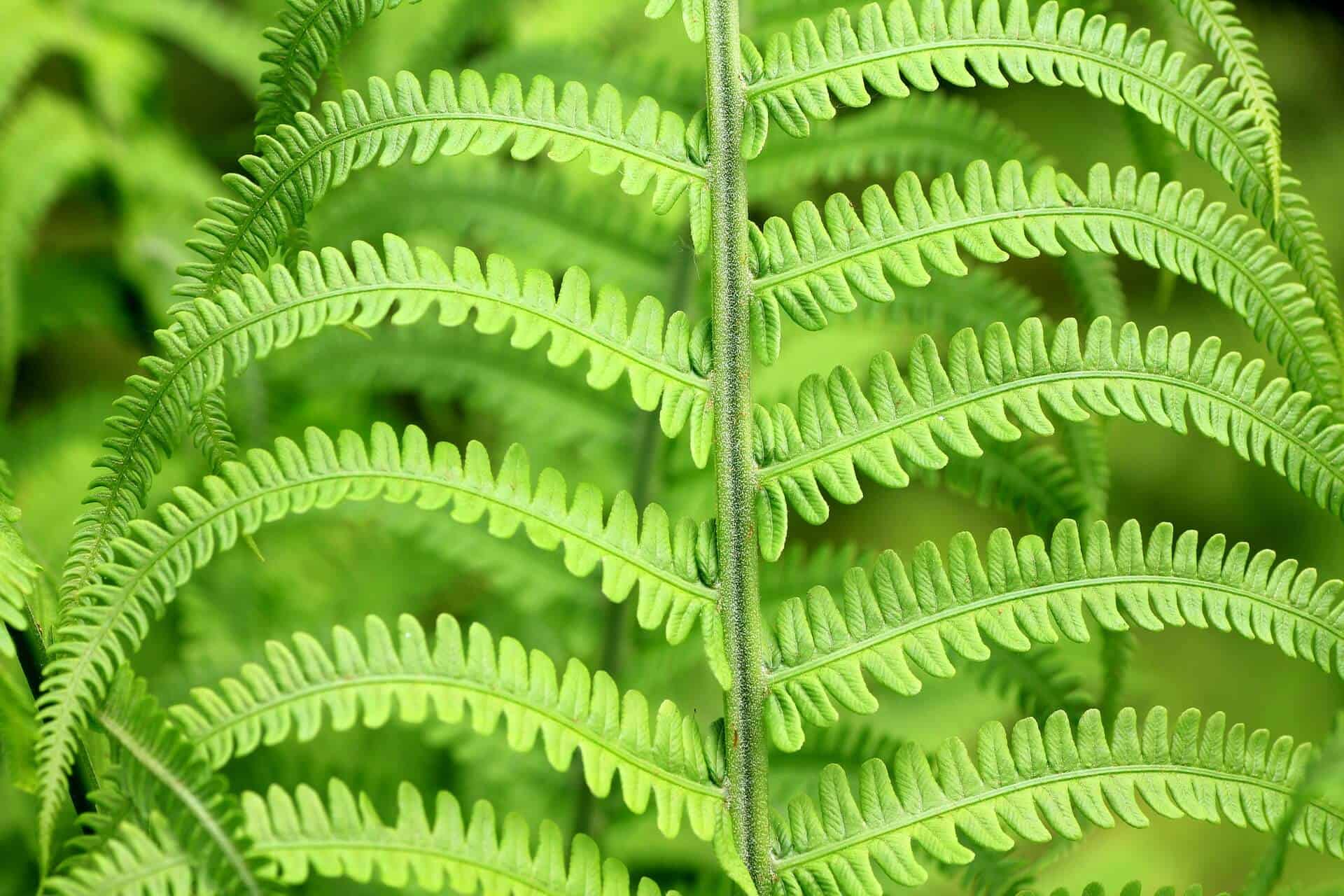
Though foraged and eaten for centuries by billions of people, bracken ferns have been the subject of debate. Bracken ferns are poisonous to many animals and contain ptalquiloside, a carcinogen. You’ll find references everyone online with statements that you shouldn’t eat it. The truth is that ptalquiloside is both water-soluble and is destroyed in heat and alkaline conditions (see United States Forest Service and The Atlantic). So sautéed or pickled, and eaten in moderation, you can safely enjoy these fiddleheads.
And, they’re delicious and fun to forage! Let me show you how.
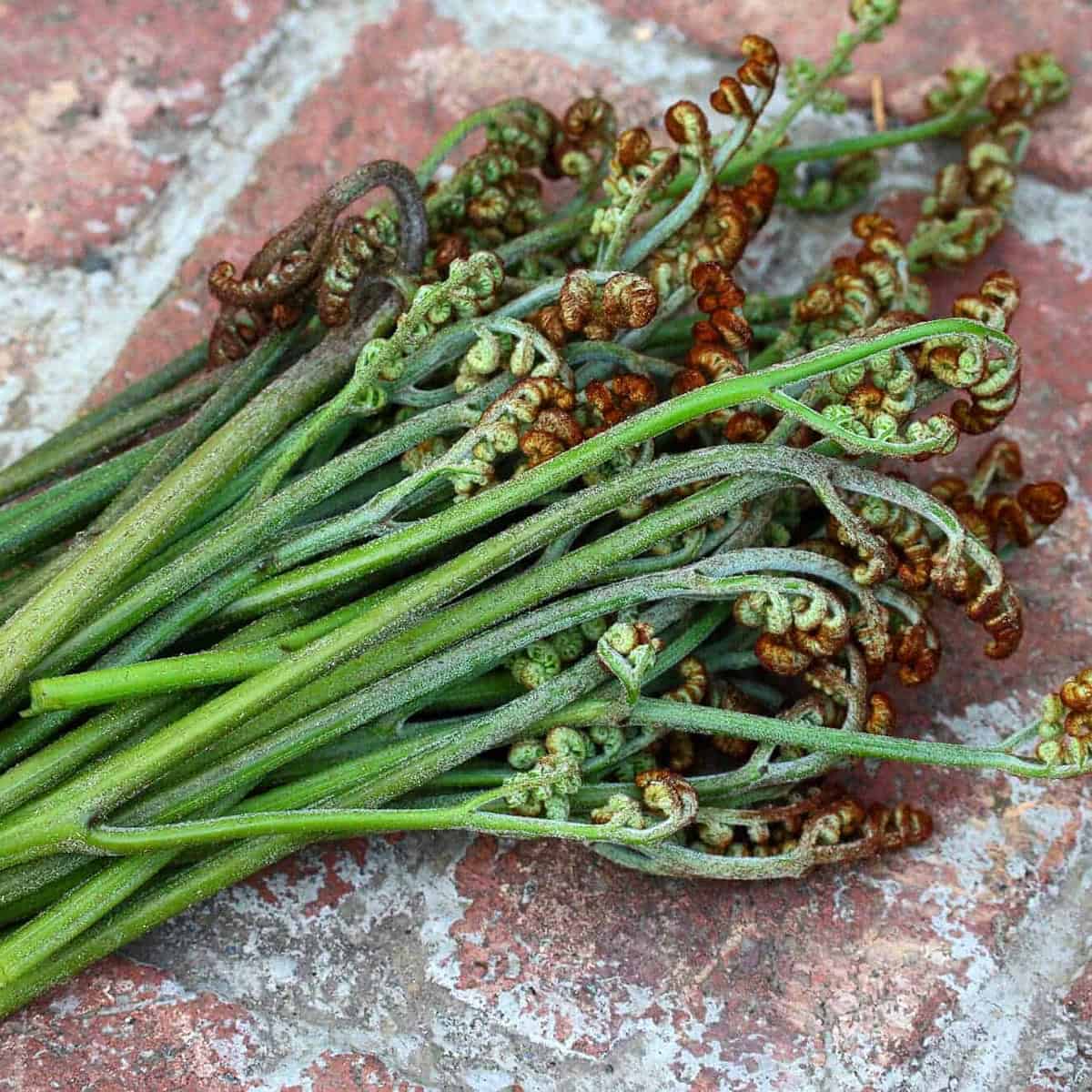
Our Spring so far has been gorgeous here in western Washington! We’ve been outside almost every day doing a variety of activities. For one, we’ve been busy prepping the huge vegetable garden on our historic 8 acres. With our kids we’ve also been spending time at the beach, discovering ant hills on our property (much to our kids’ delight), hiking in the local forests, and…foraging for wild edibles.
We’ve been hiking around with our medicinal and general plant identification books and our kids have been having a blast learning how to identify and forage nature’s bounty. One of the books we like and highly recommend for those of you in the Pacific Northwest is Pacific Northwest Foraging. (You can also find books for other regions as well as edible plants across all of North America and Britain and Europe.)
It contains large color photos of the plants from various angles to help you identify them, discusses their features, flavors, when to pick them and how to prepare them. It’s a handy guide, user-friendly and the color pictures make it easy to reference and fun for kids to use.
We’ve been foraging away with our kids, eating some things fresh and drying others for long-term use.
Right now is bracken fern season – come join us for the hunt!
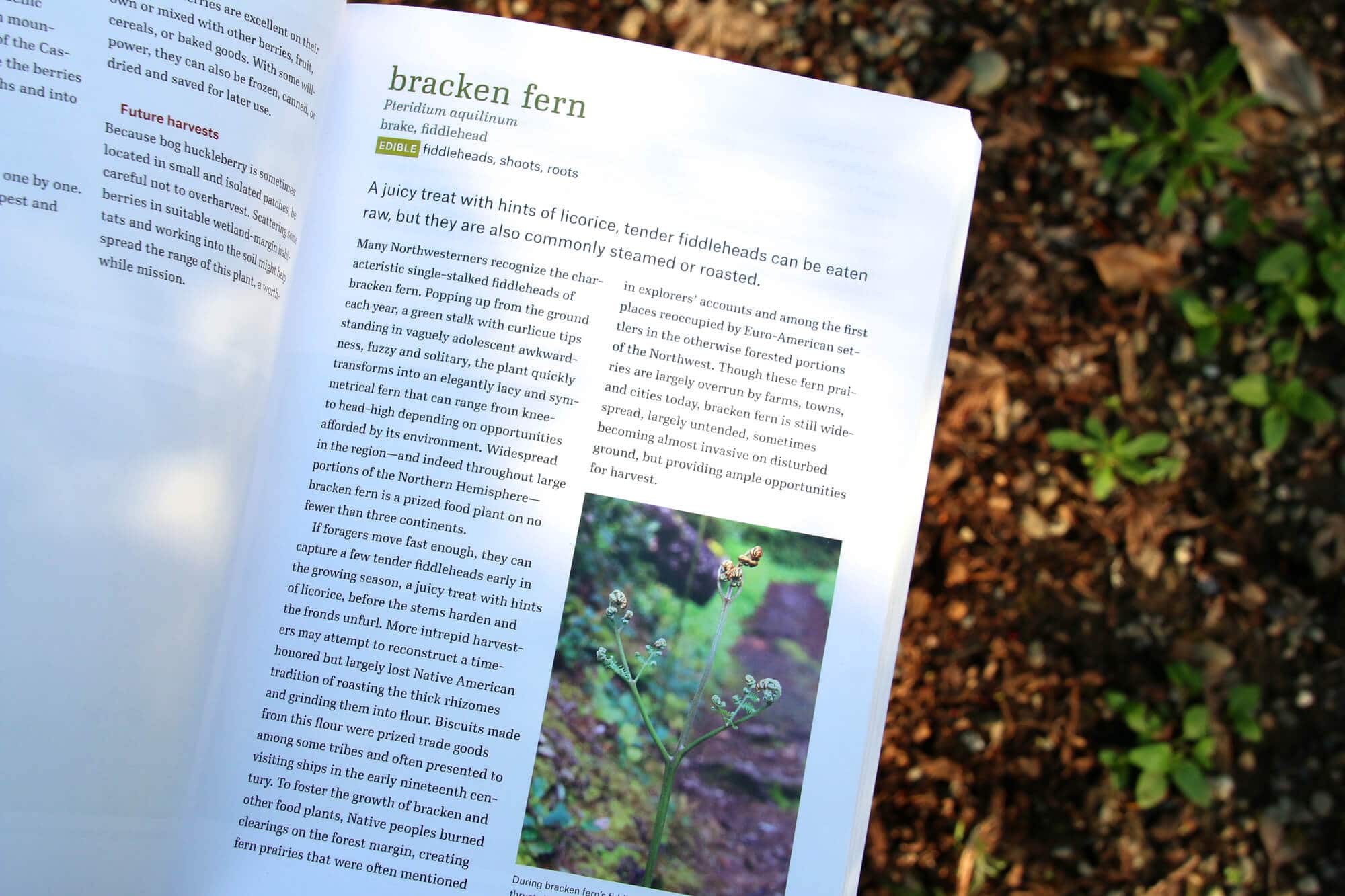
We equipped our kids with our plant identification book and let them lead the way in finding them.
They had a blast playing “plant detective” and were soon on their way!
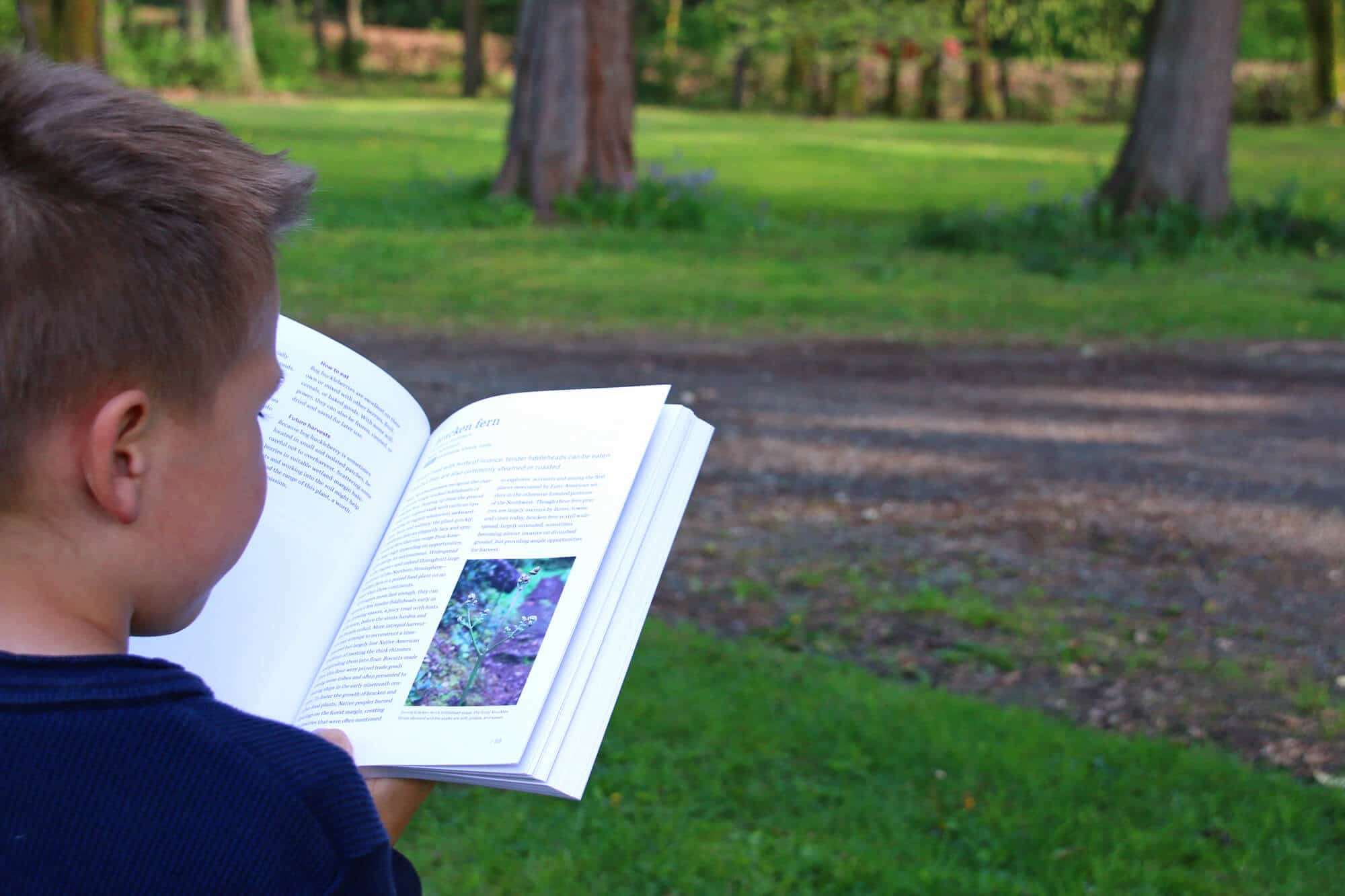

We explored our property looking for bracken ferns.
A couple of days later we went hiking in the forest and found more there as well.
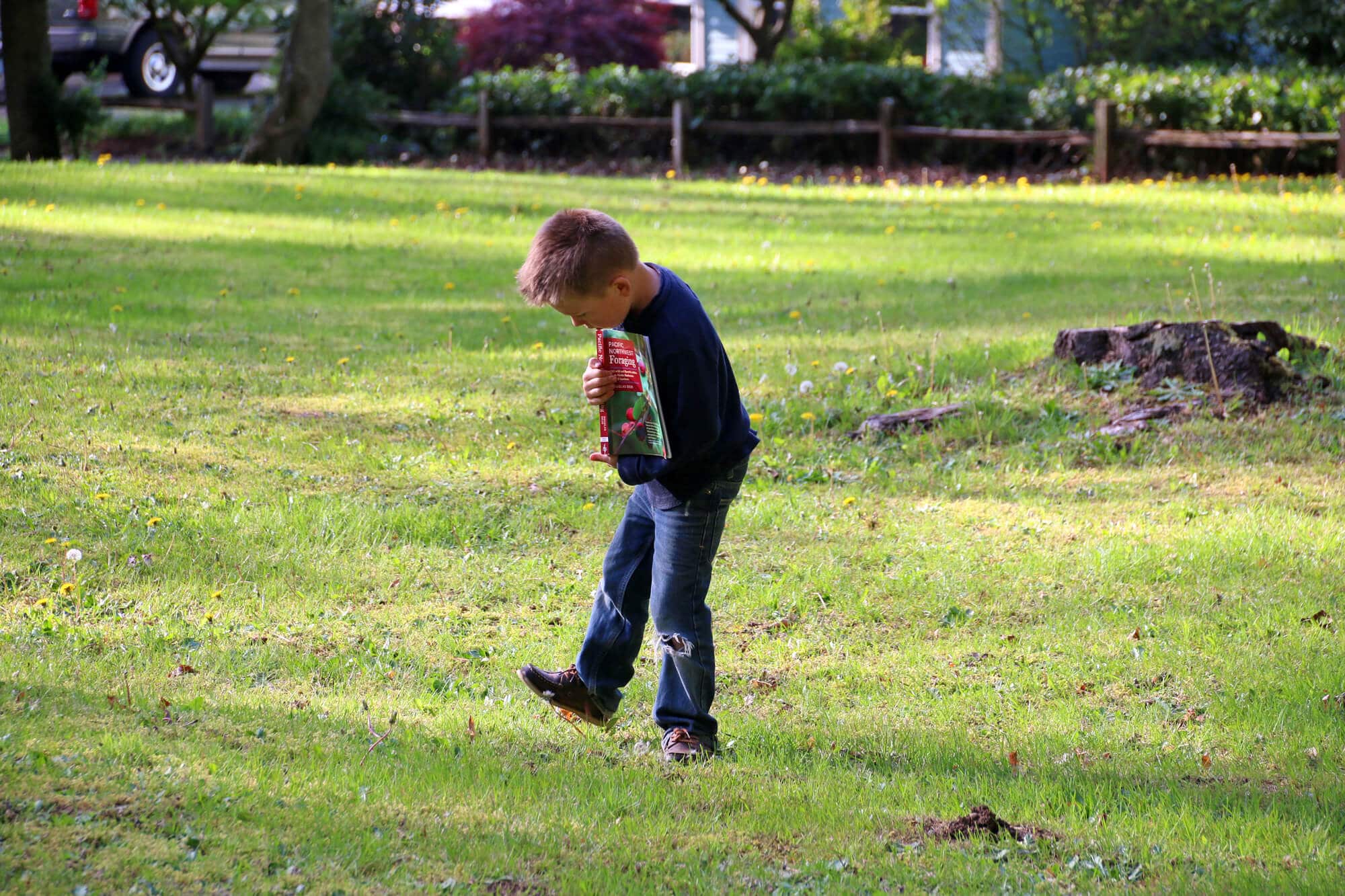
Turn around, they’re right behind you….
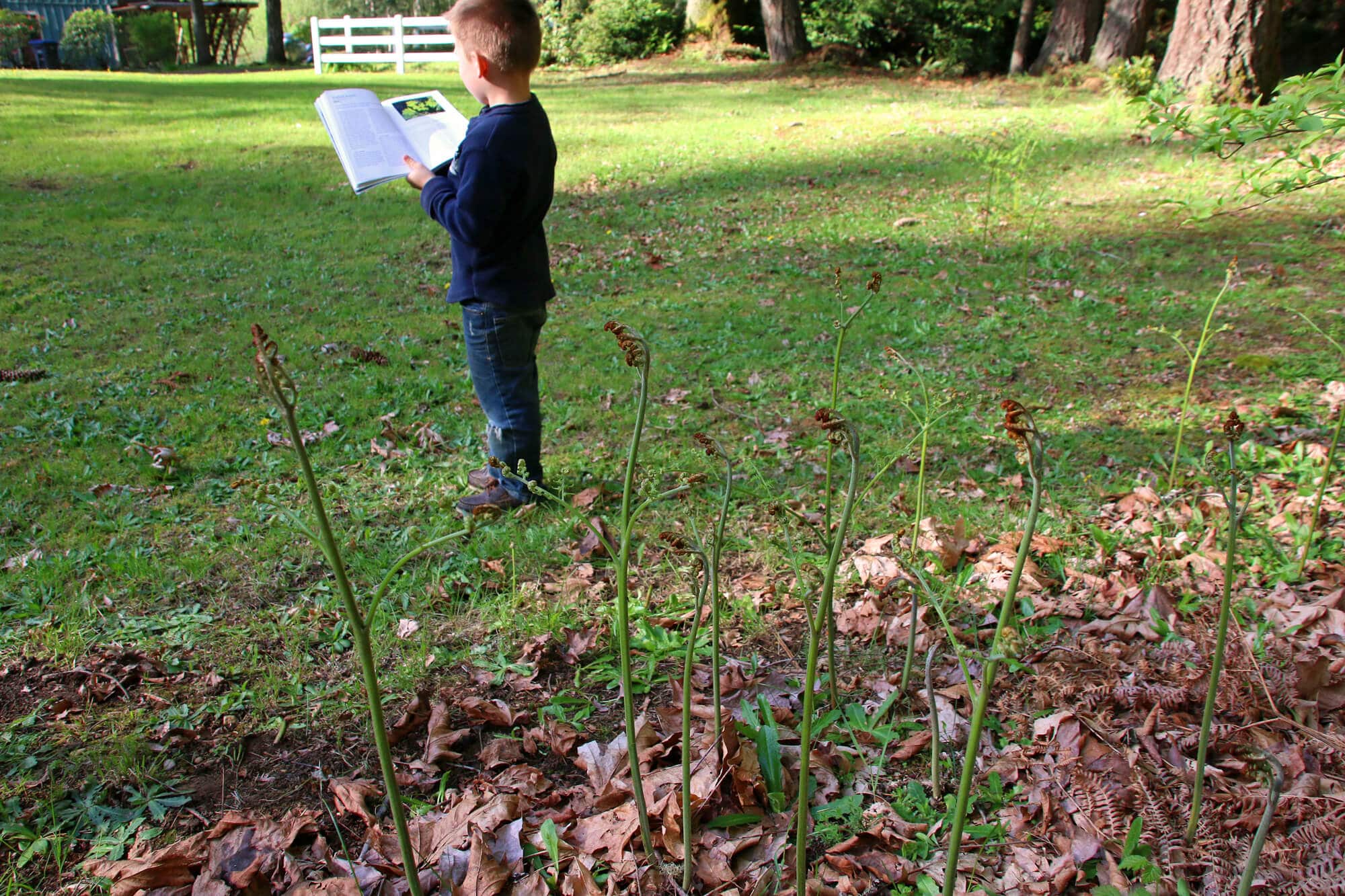
Pssst, they’re right in front of you….
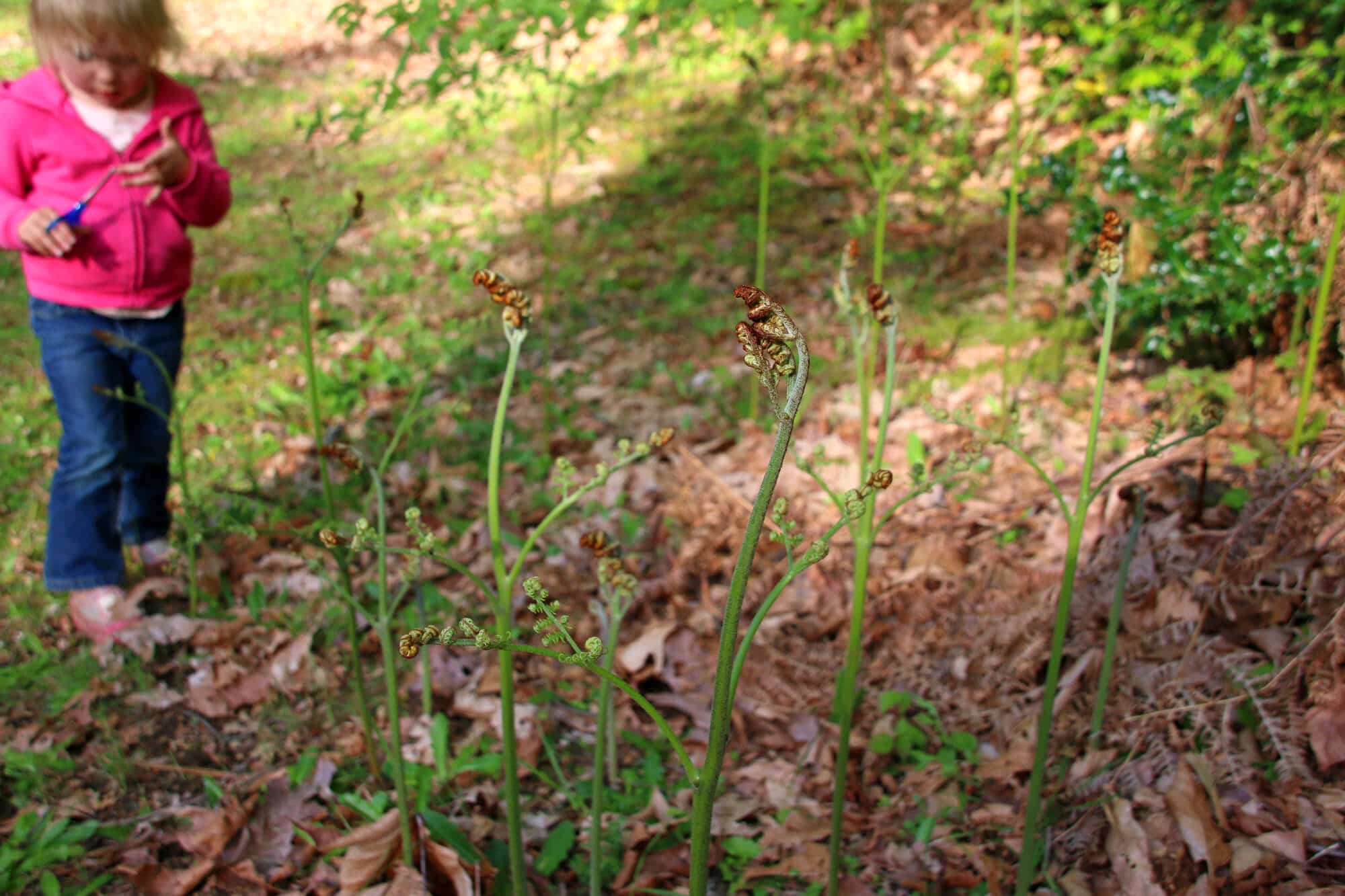
There they are!!
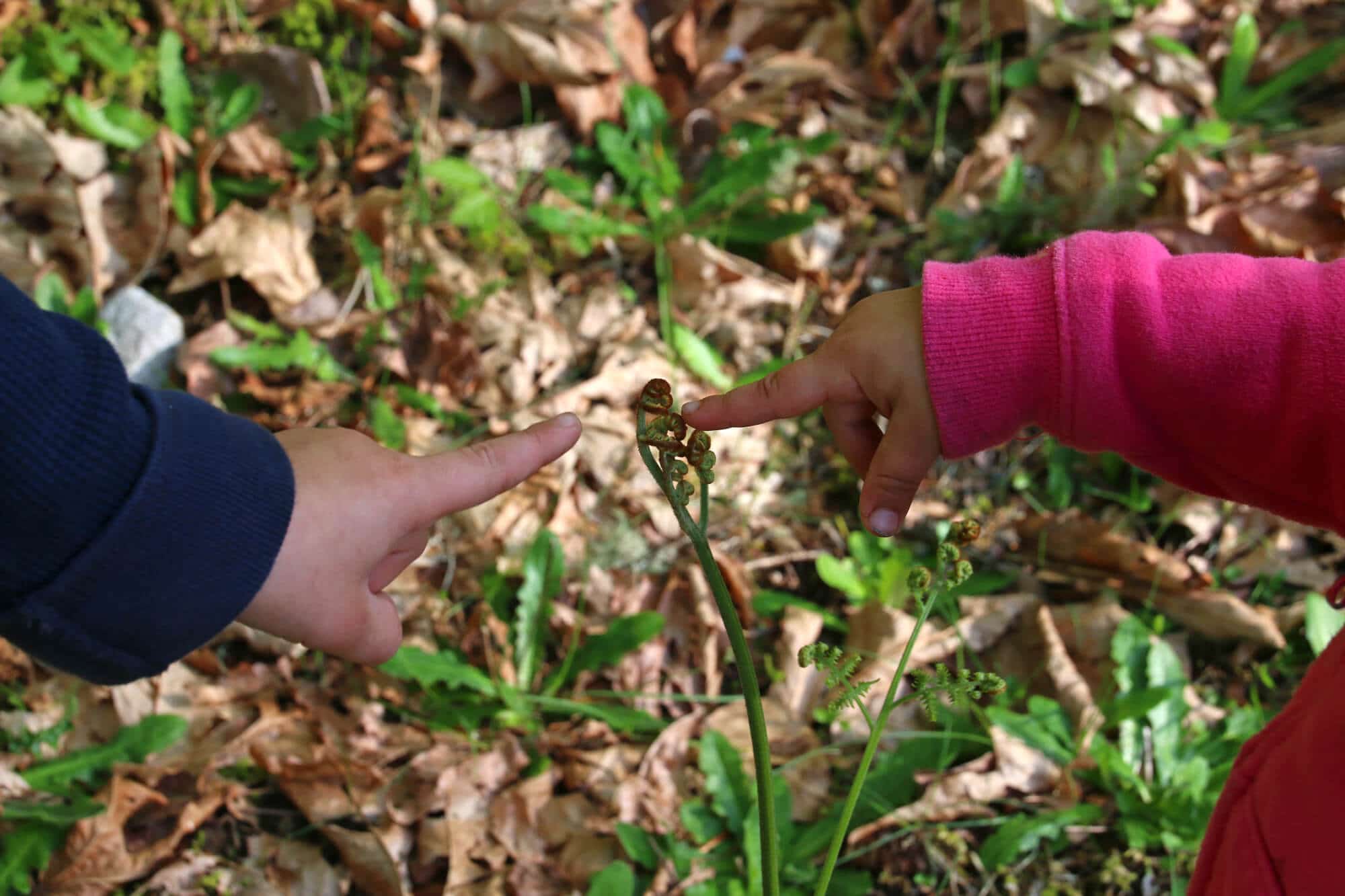
Bracken ferns need to be harvested while they’re young and immature, while their fronds are still curled up.
They’re hard to miss with their tall straight stems and curly fronds on the top.
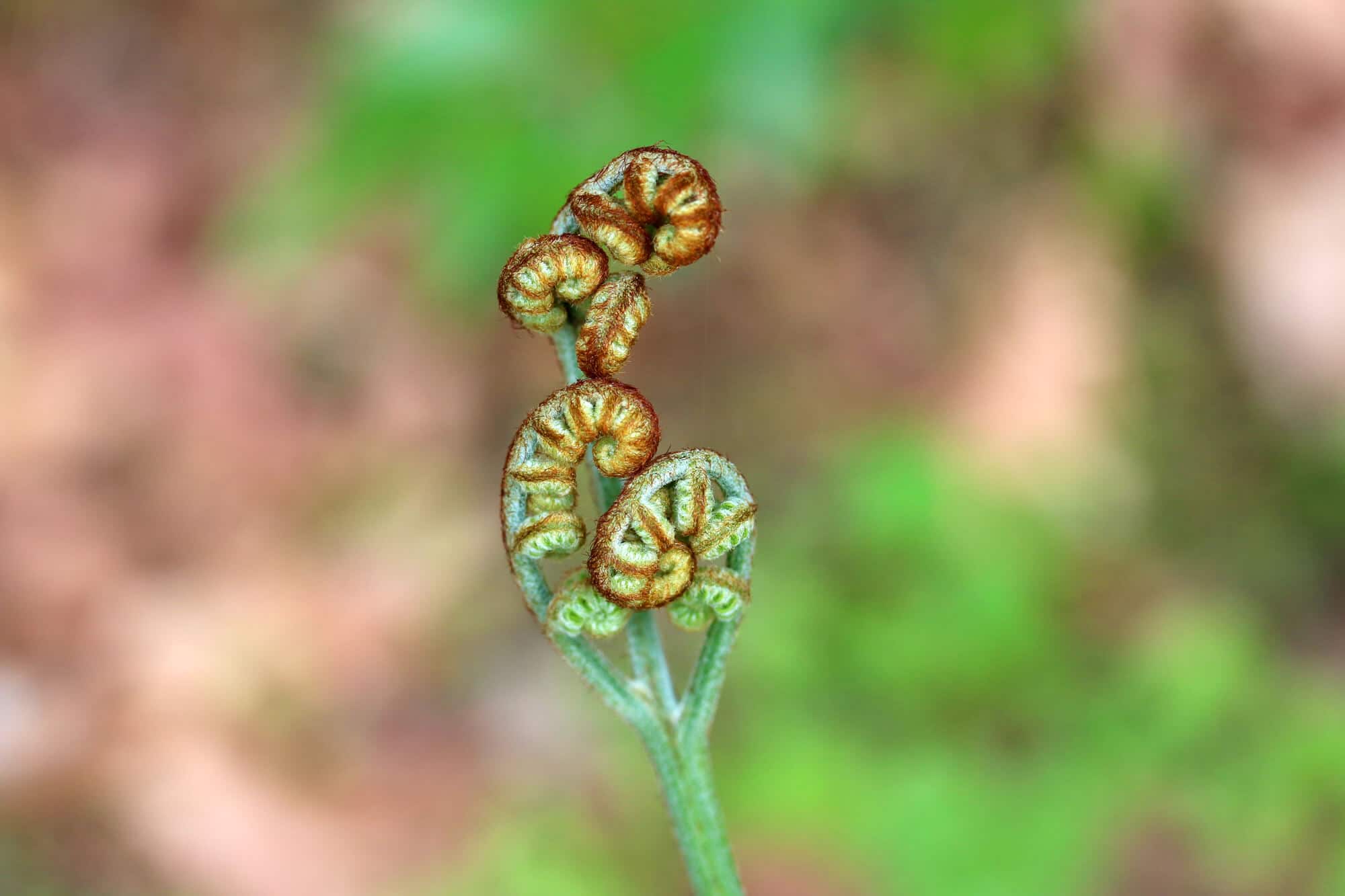
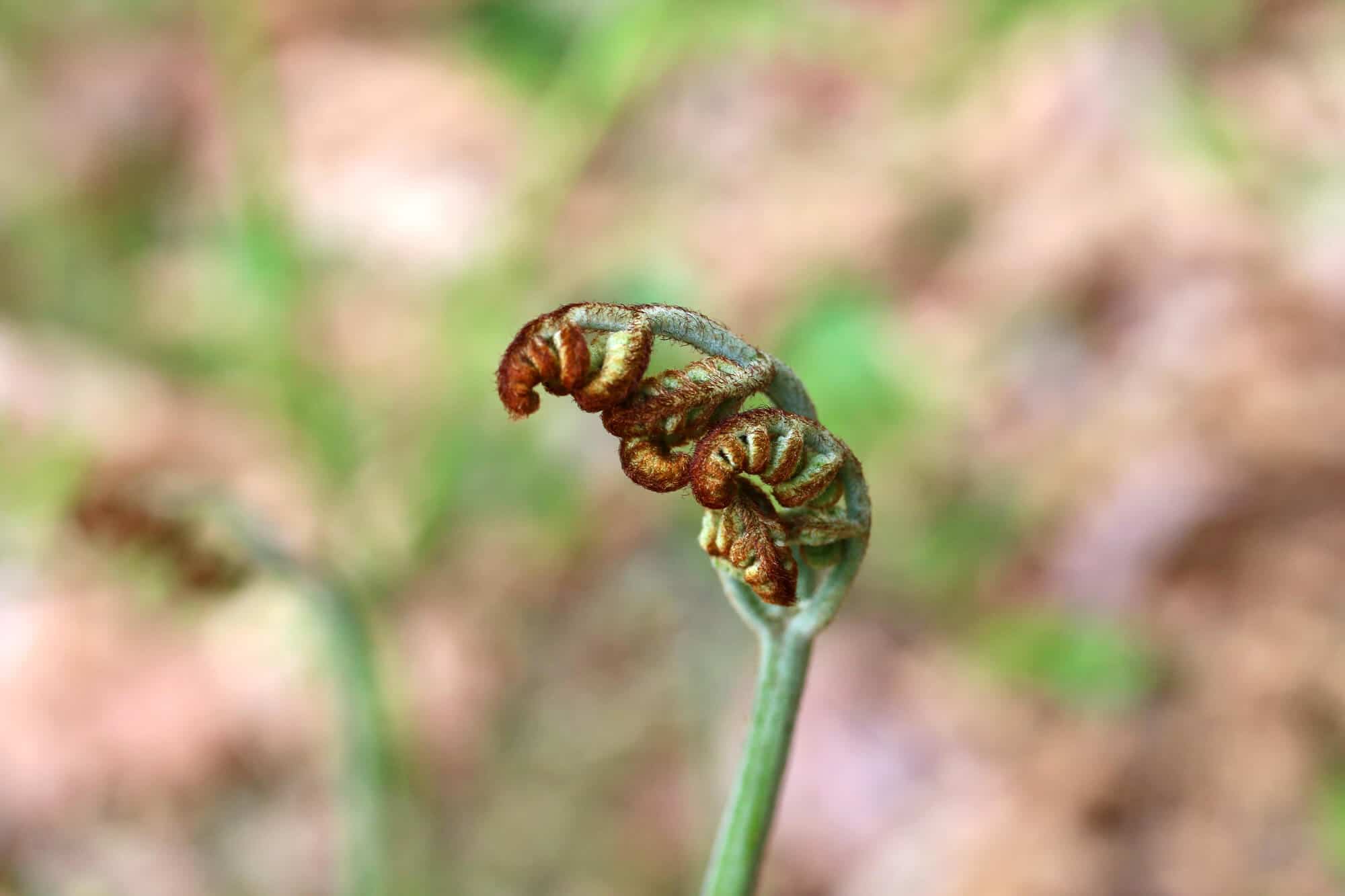
Depending on the height of the stalks, you’ll pick them about 5 inches or higher above the ground (for tall ones) or as little as an inch from the ground if they’re short.
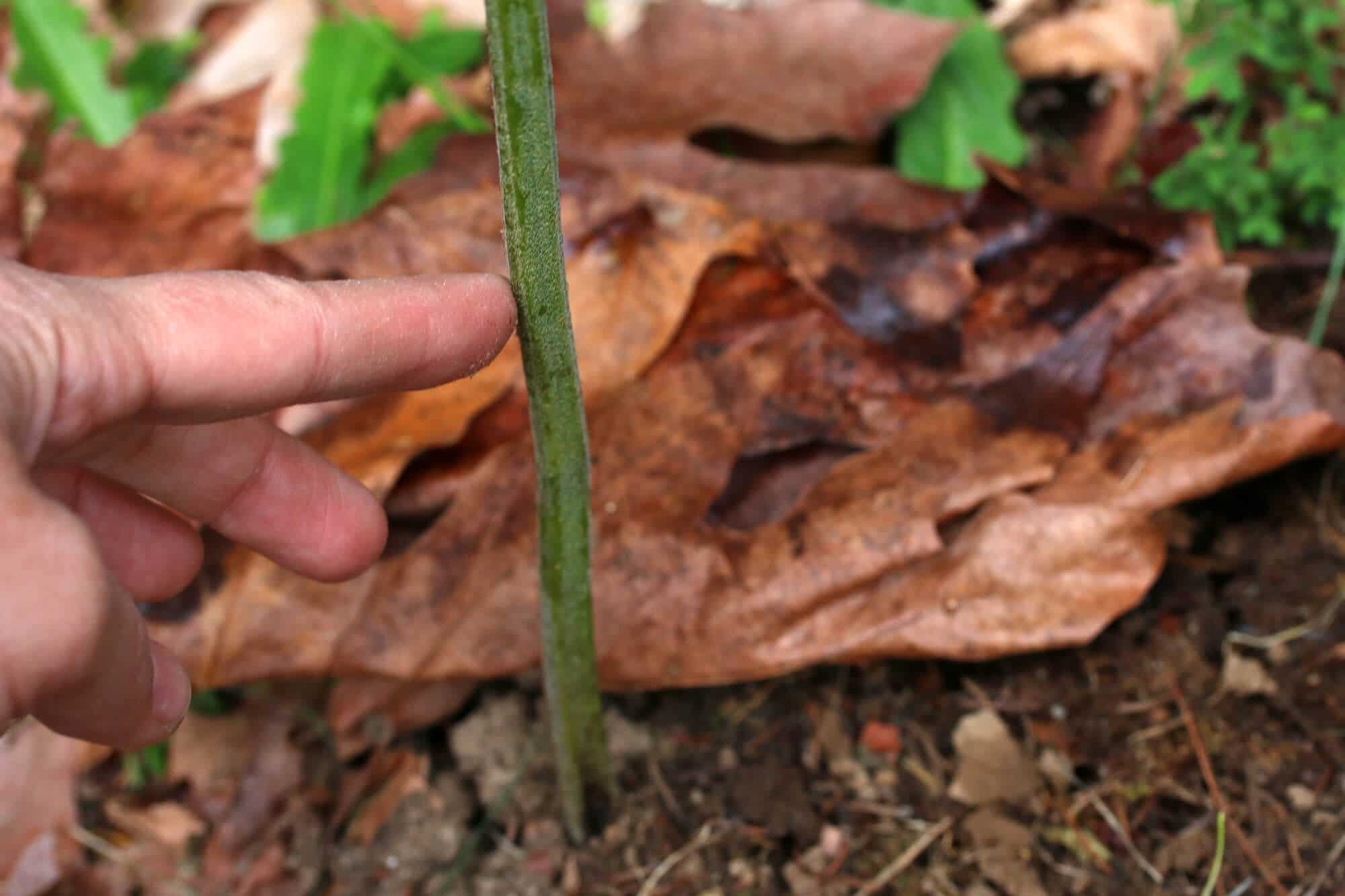
You’ll be able to tell where to pick them based on how they break.
If they bend and don’t readily snap you’ll know to pick them higher up.
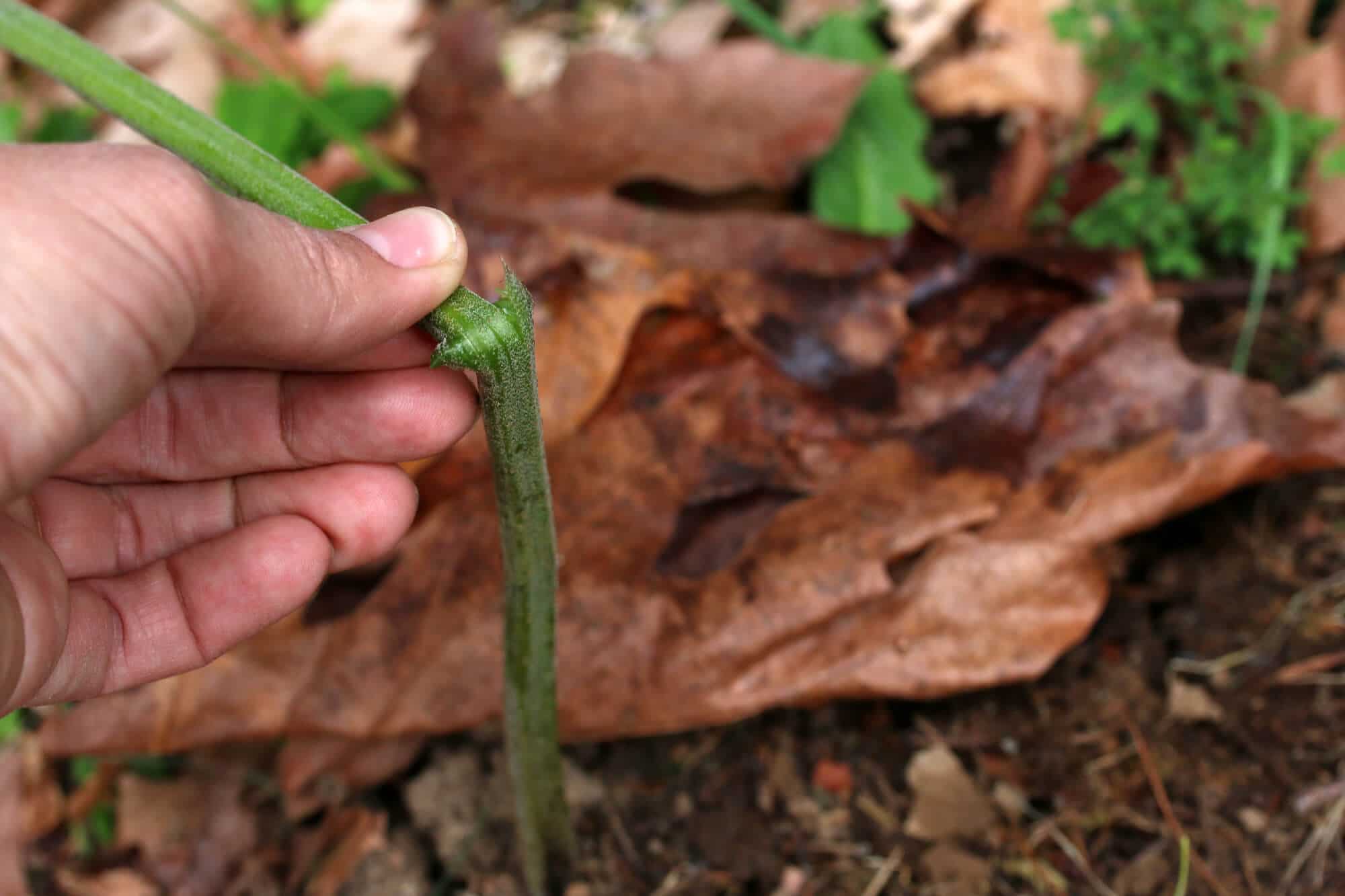
Another two inches higher on this one….it will give a very audible “snap” with a clean break, like tender asparagus.
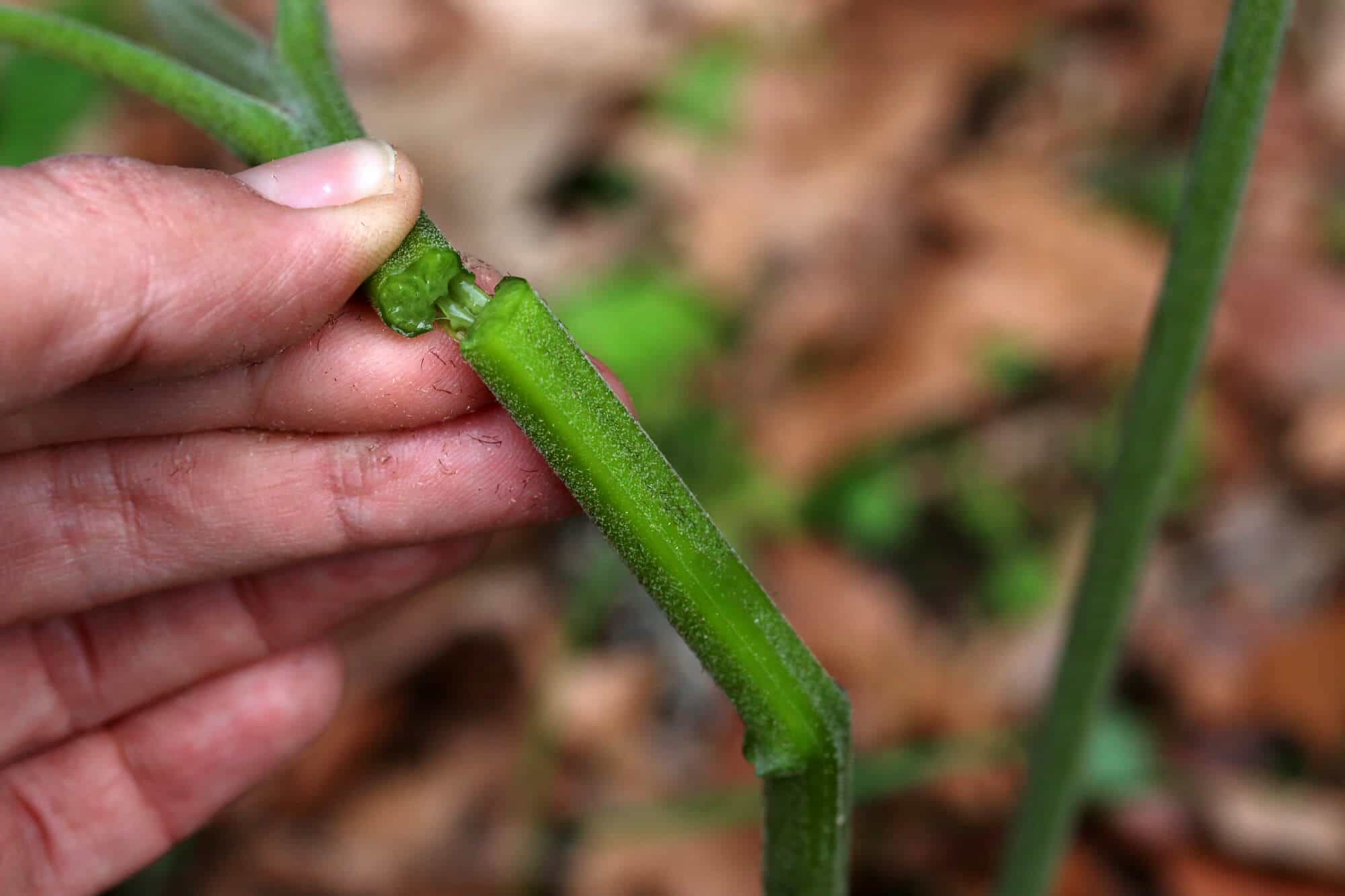
We foraged a good batch of them to take back to the kitchen.
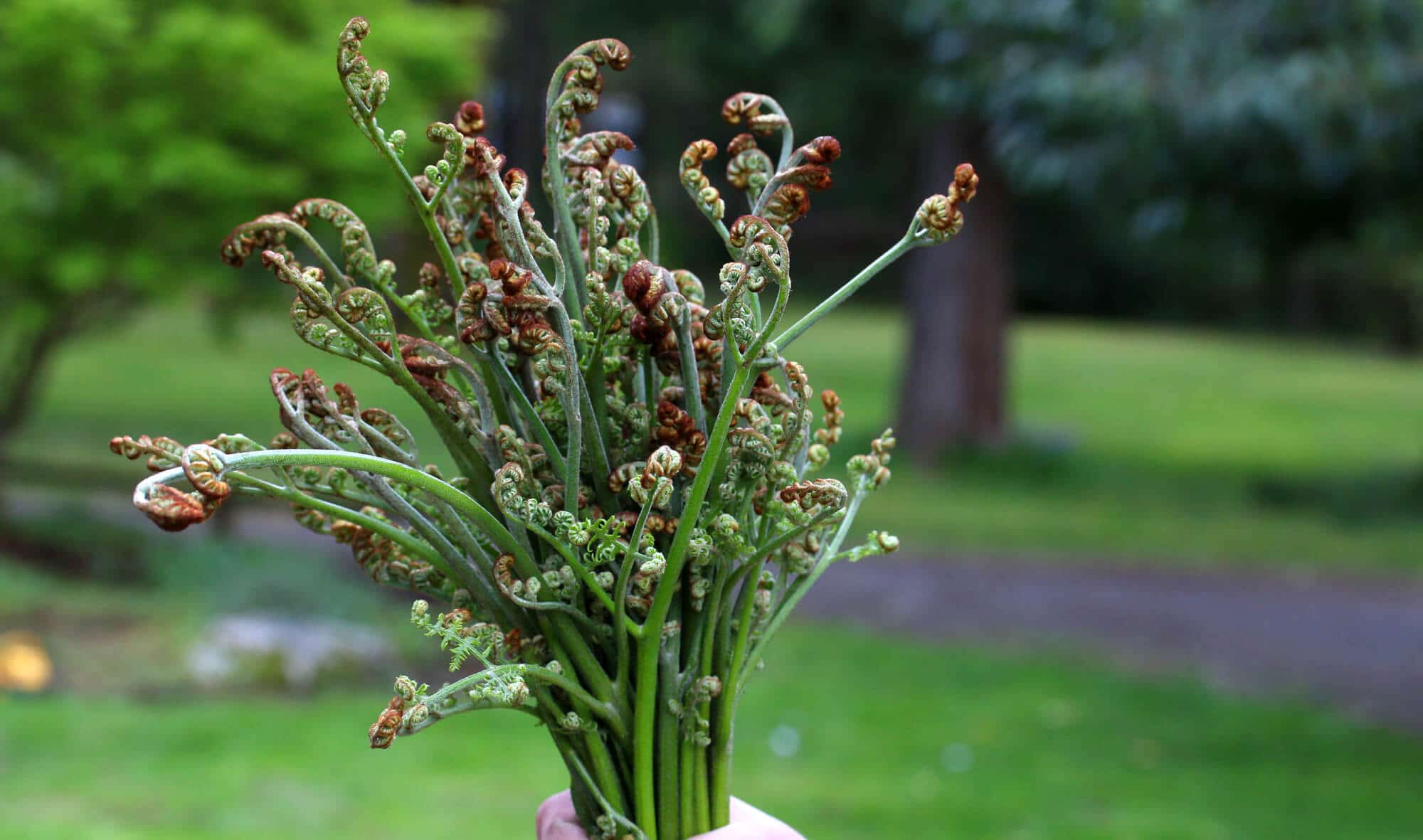
And bracken ferns weren’t the only thing our kids found!
A garter snake may be harmless but still….YIKES!!! Turns out it was already dead.
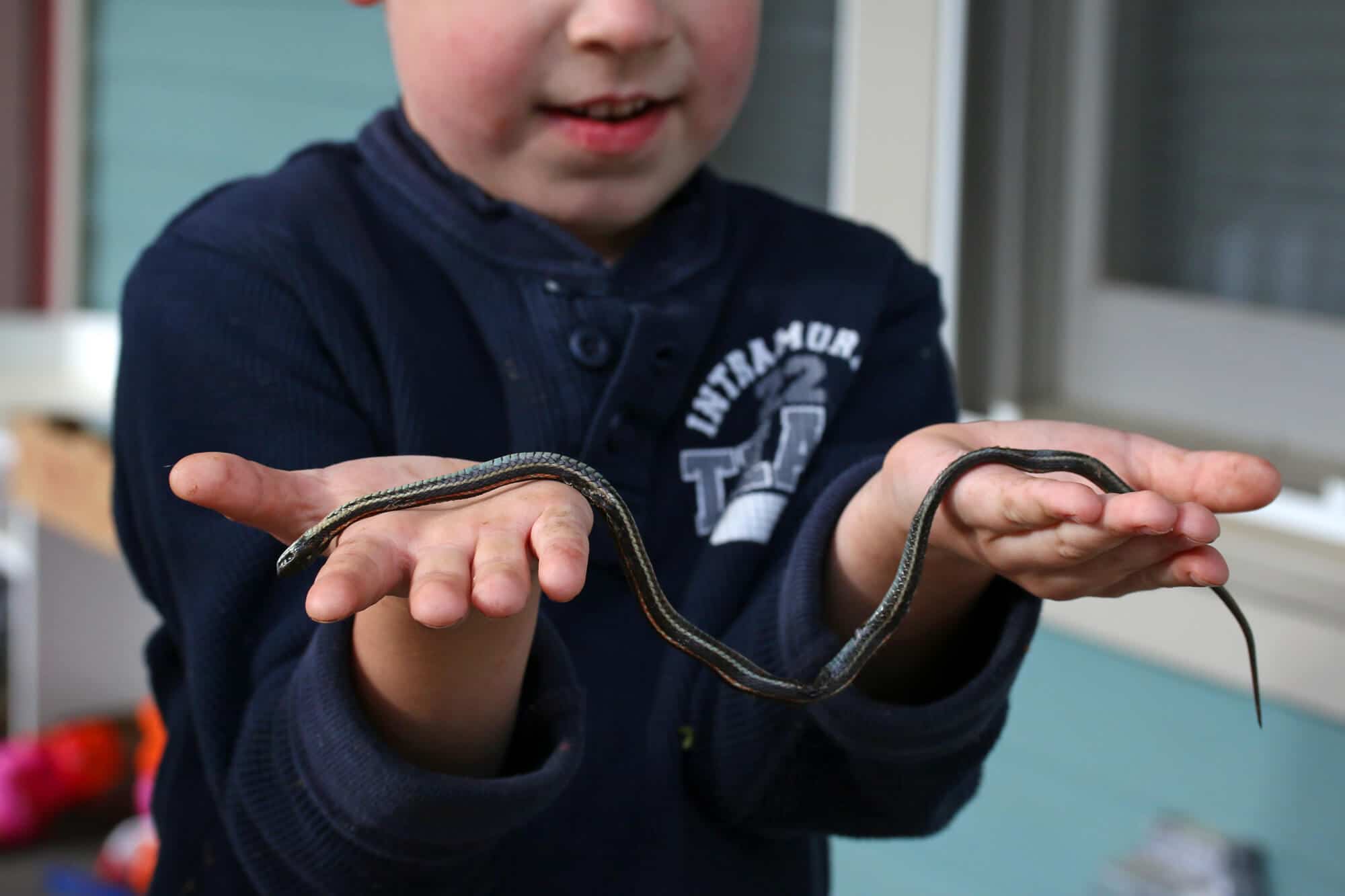
Our proud little foragers with their first trophies of the season!
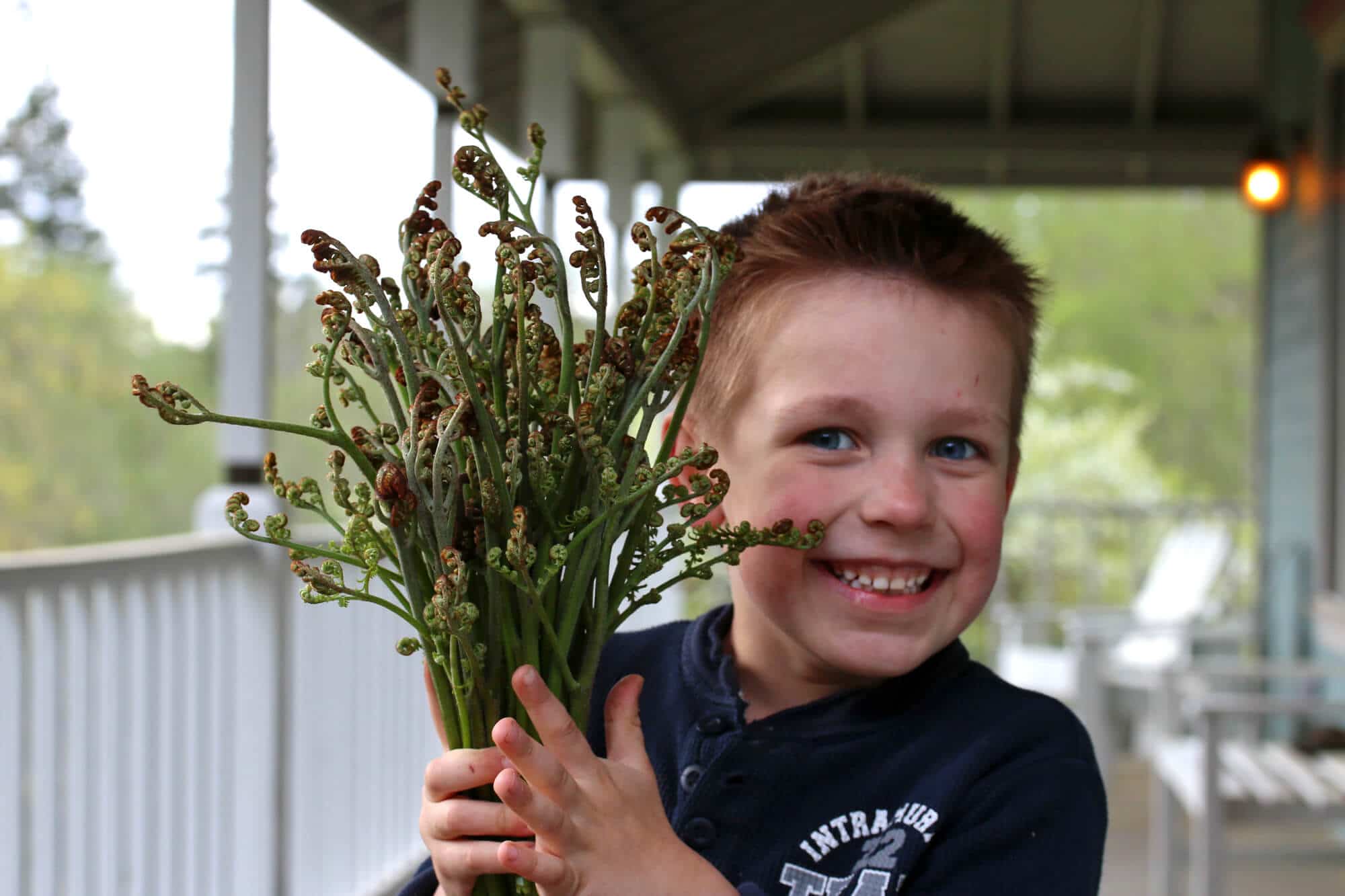
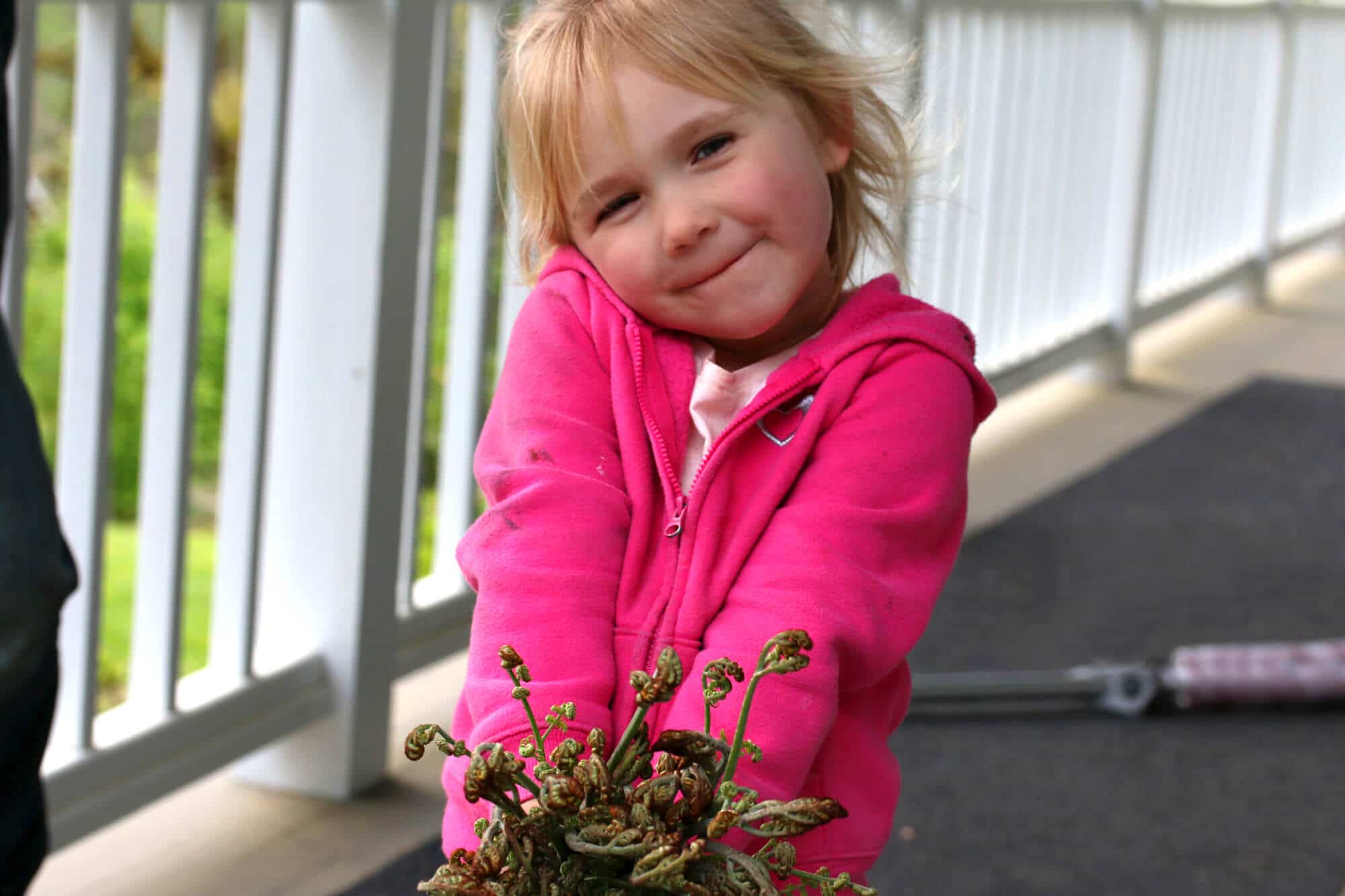
How to Cook Bracken Fern
Bracken fern stems are covered with soft tiny hairs that will easily come off when you rub your fingers across them and they’ll come off when they’re boiled as well. They’re harmless.
One of the best ways to prepare bracken ferns is to blanch and then sauté them.
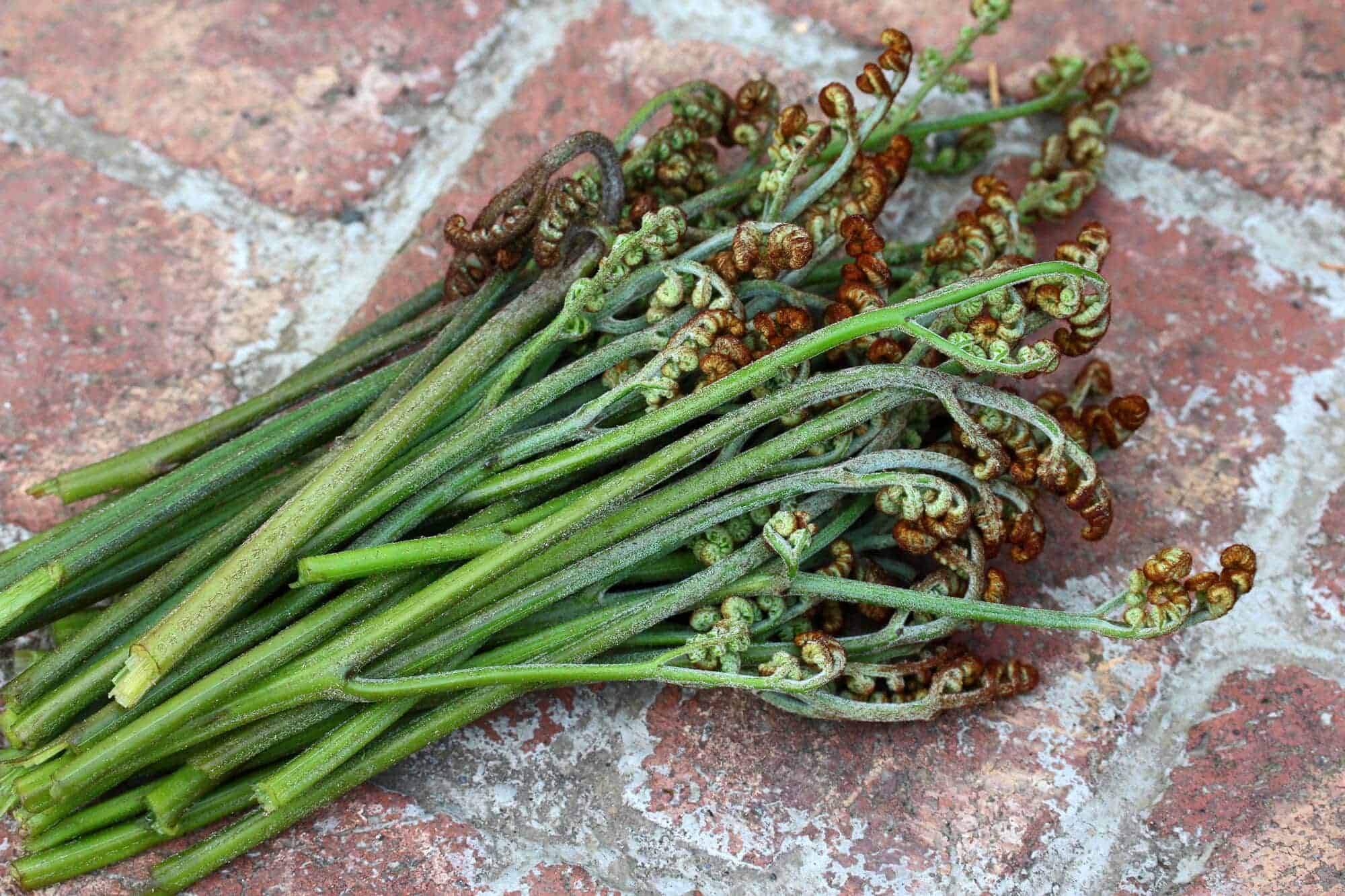
Get a bowl of ice water ready.
Add some salt to a pot of water and get it boiling.

Wash the ferns, drain them, and the drop them in boiling water for 2-3 minutes to blanch them.
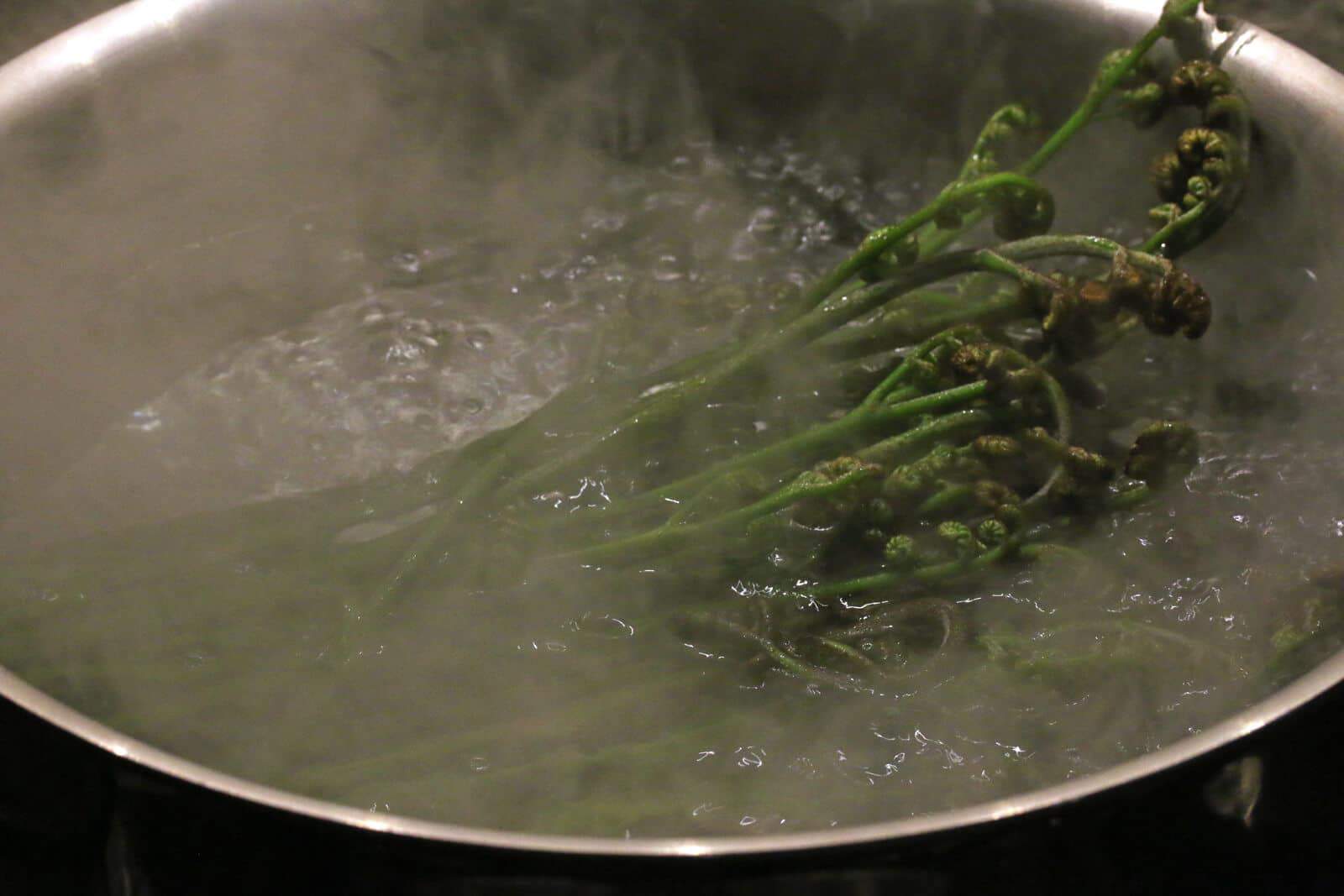
Immediately place them in the ice water to cool down.
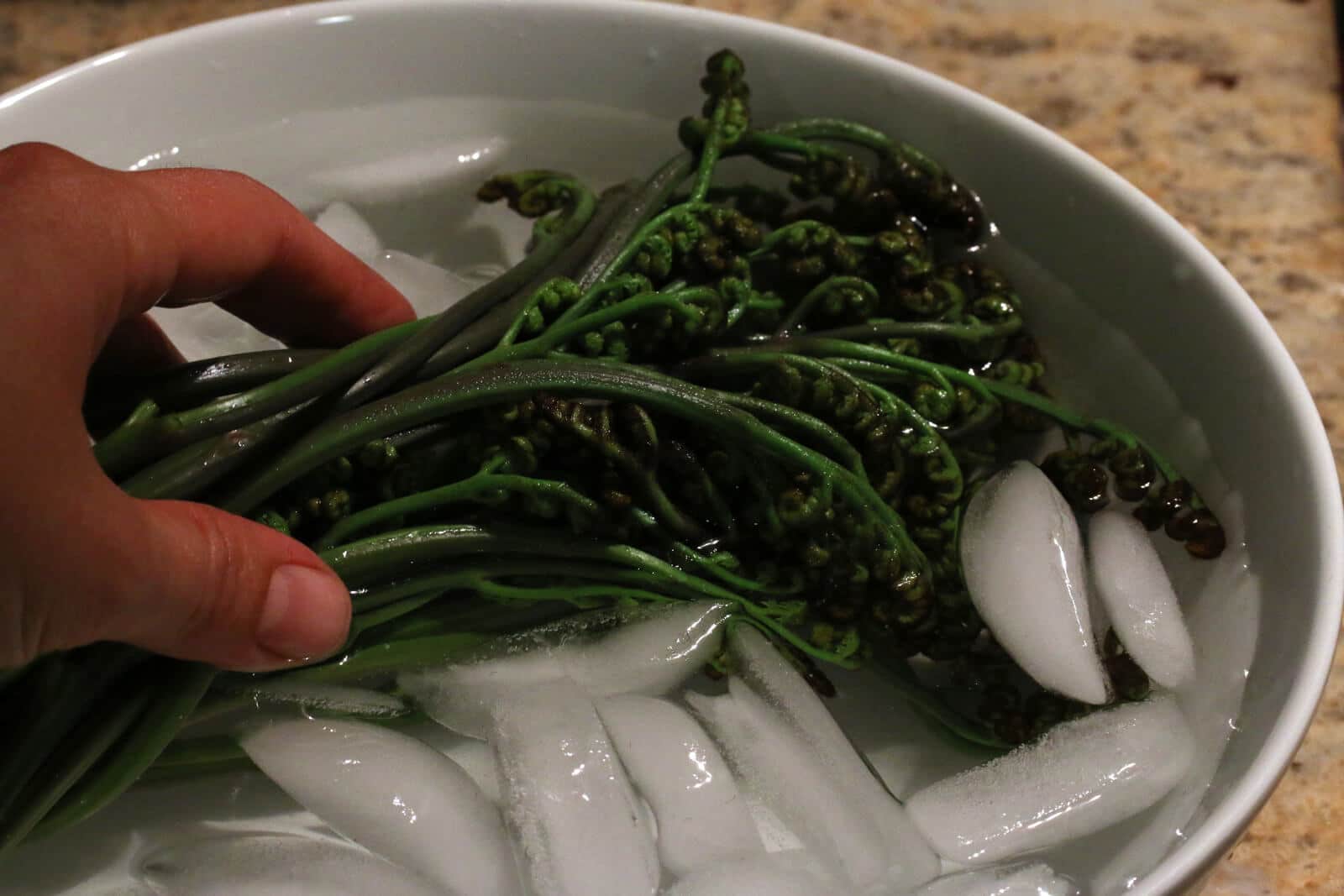
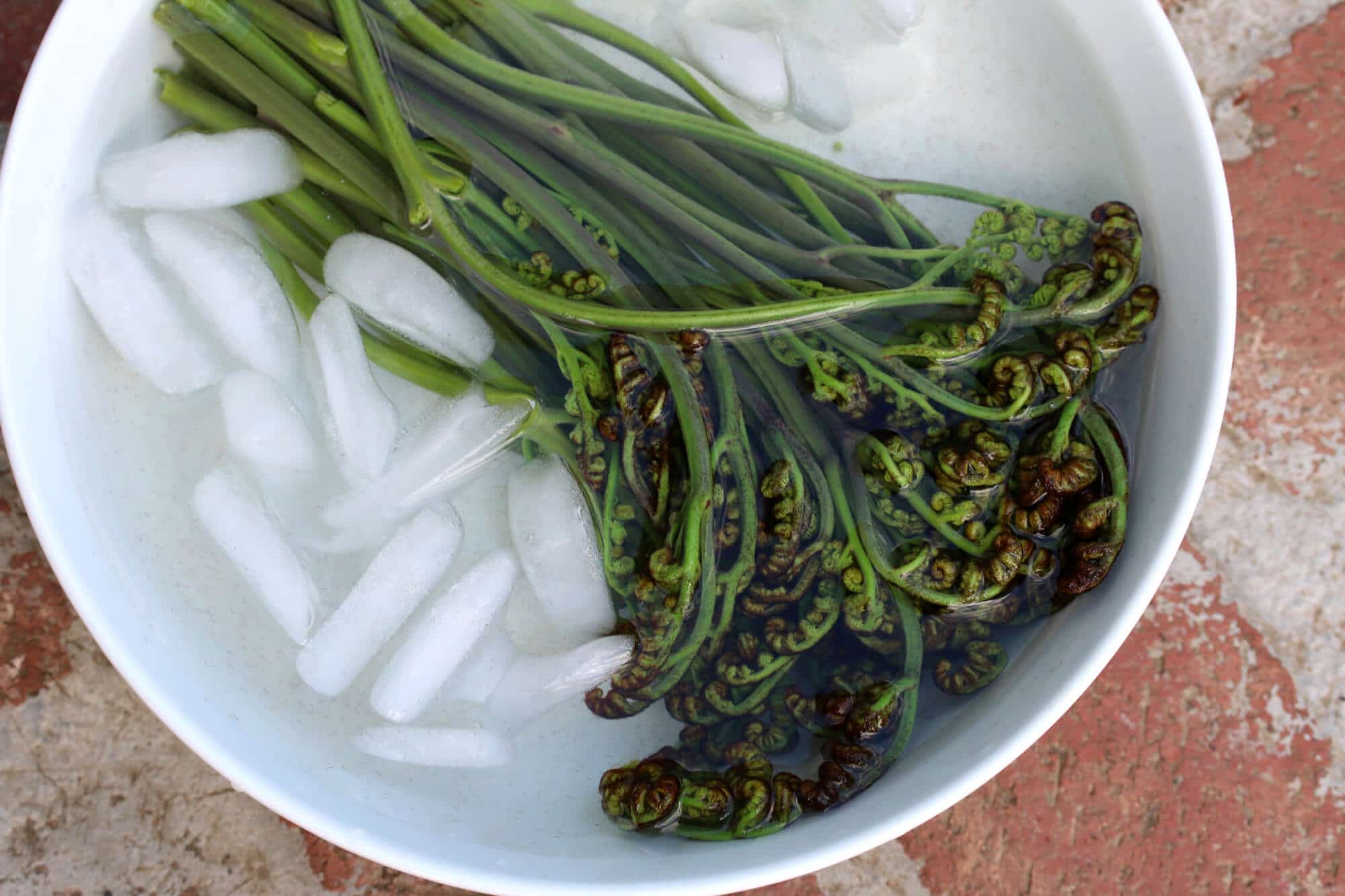
And now we’re going to sauté them in butter.
I’m also going to add a few fresh herbs from our garden.
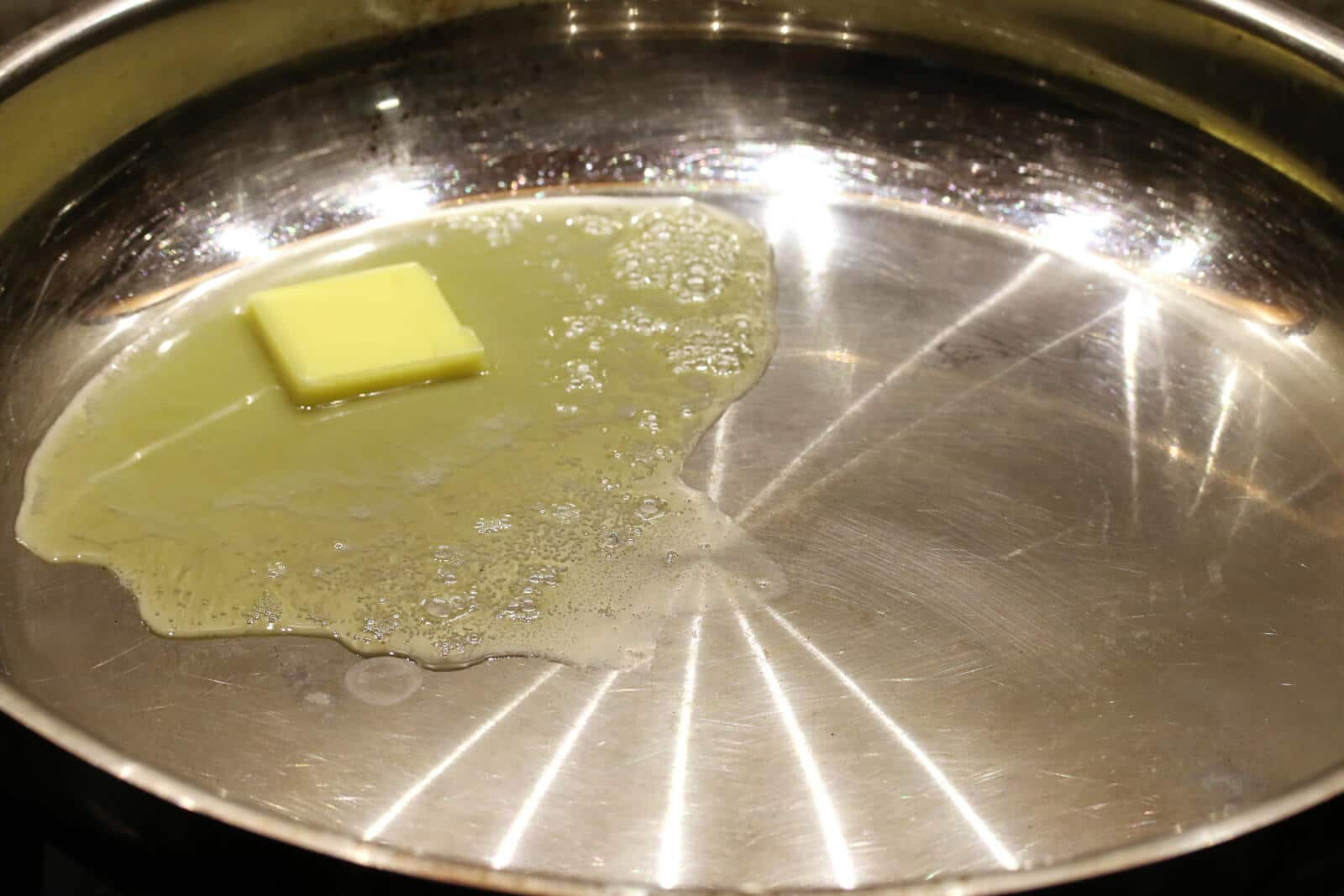
Sauté them for 2-3 minutes. You don’t want to overcook them. Like asparagus you want them to be crisp-tender.
Add a little more salt and a grind or two of pepper.
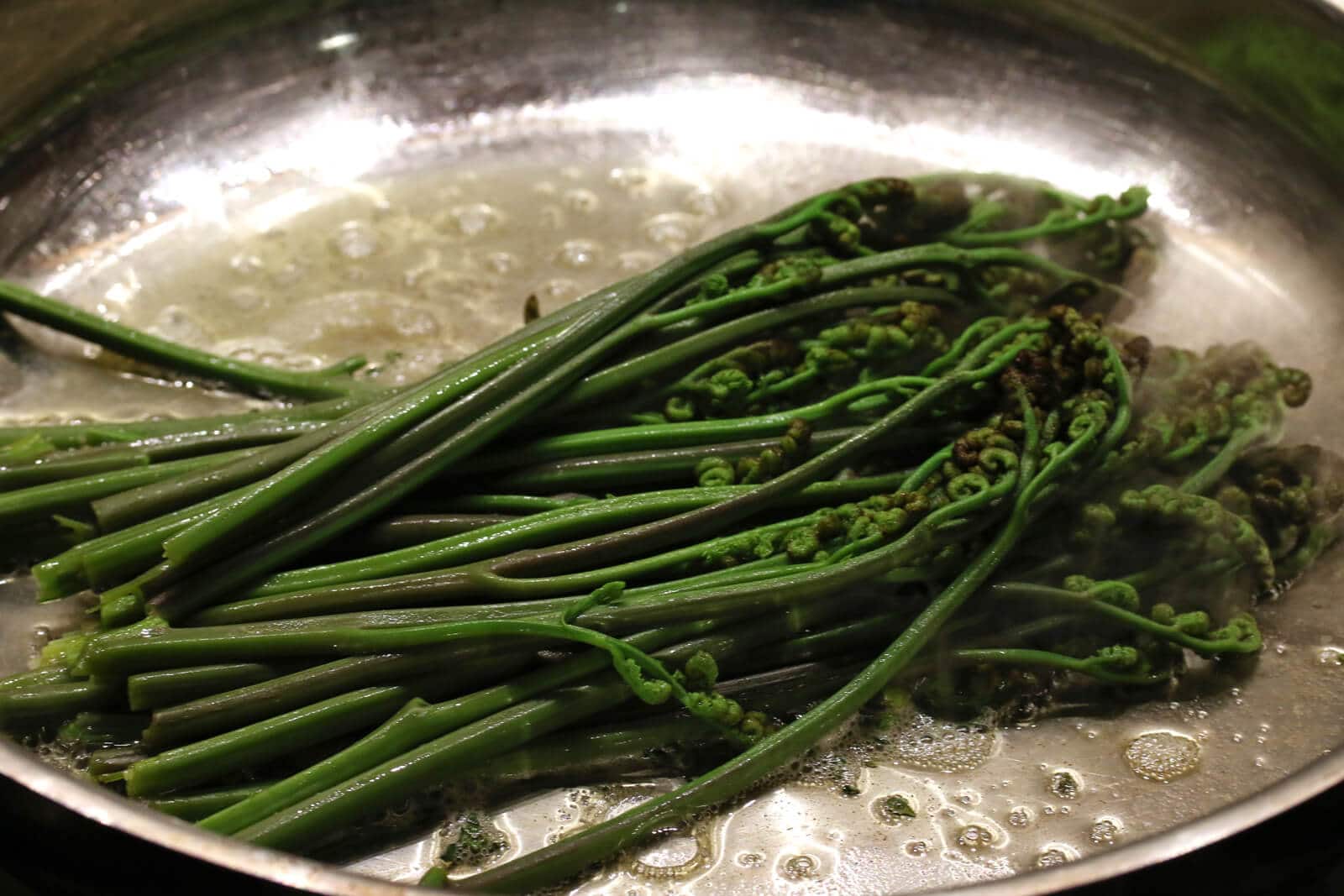
Serve immediately.
One of nature’s delicious bounties!
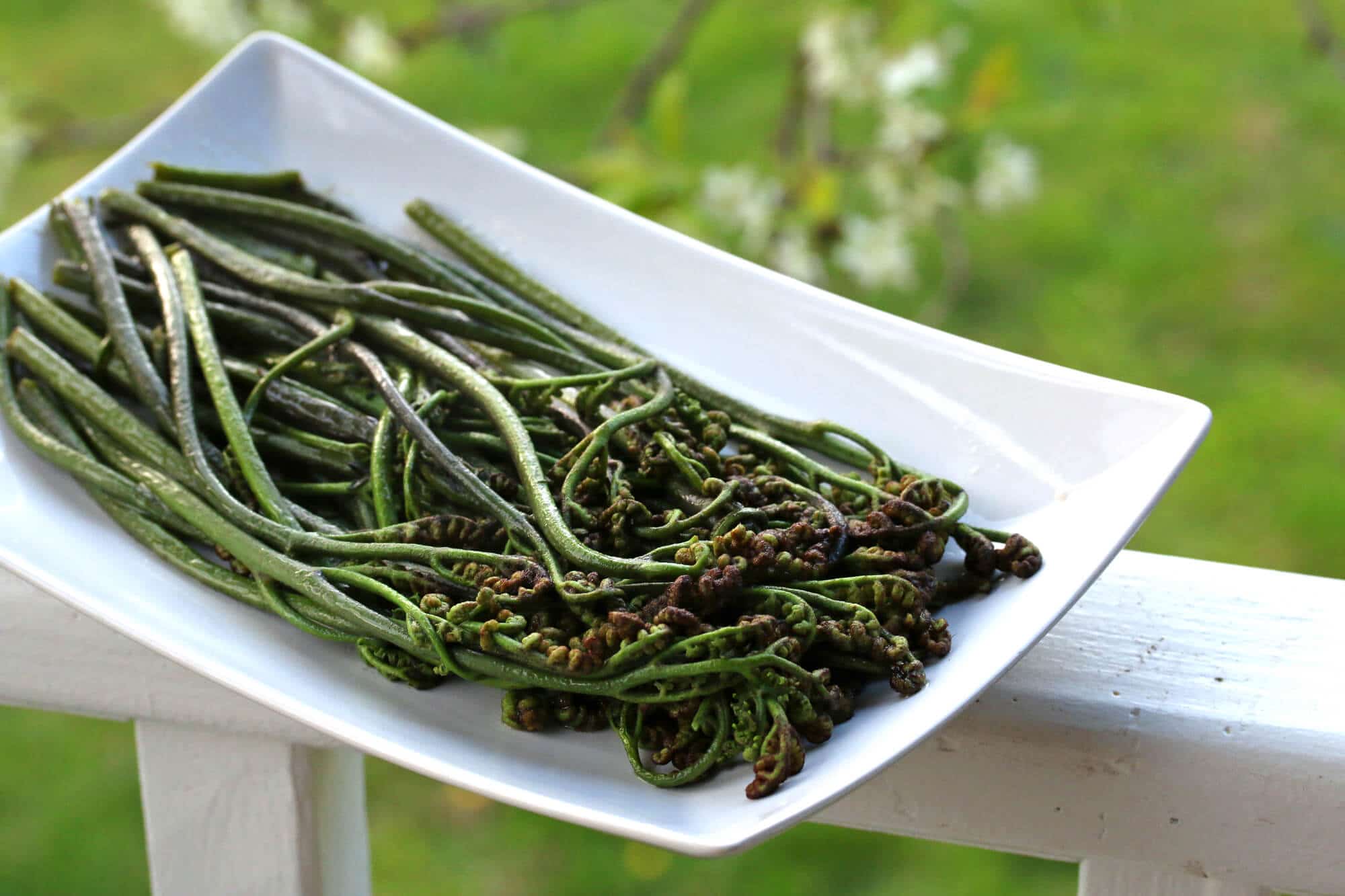
The next time you’re out enjoying nature take a look around you and there’s a good chance you’ll find some fiddleheads. Snap a few off and take them home with you try. You’re going to be pleasantly surprised!
See you next time for another installment of my Wild Foraging series!
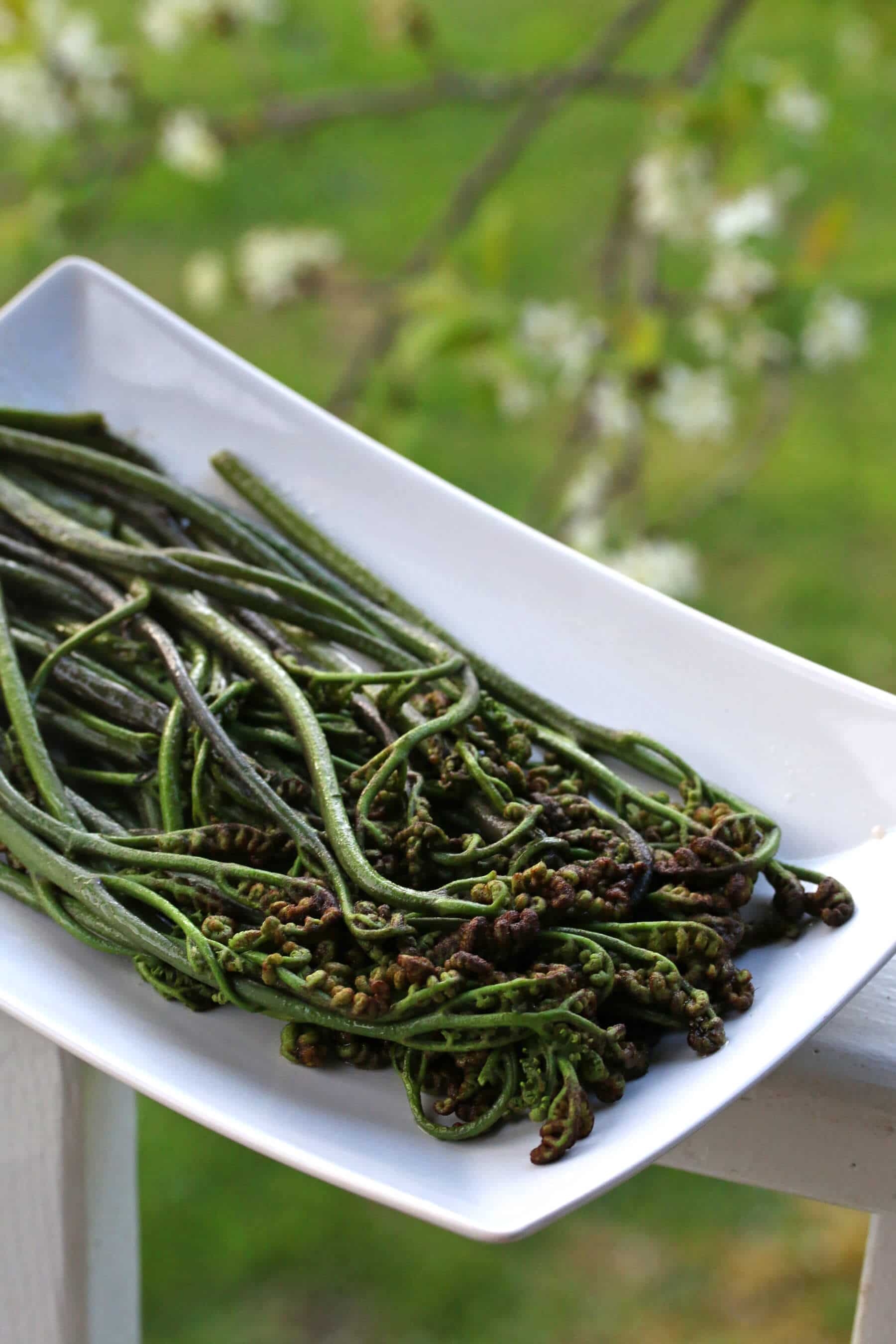
Disclosure: To ensure safety and selection of the correct plant, refer to diagrams and descriptions from a reputable plant identification guide.
Originally published on The Daring Gourmet April 22, 2016


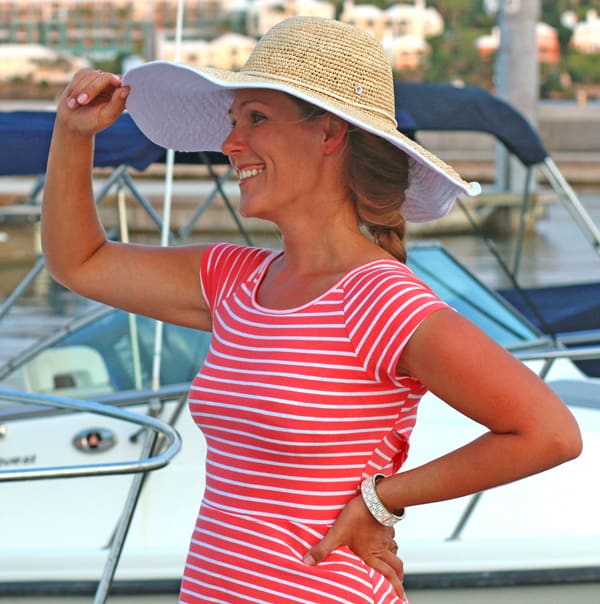

















Thank you for your post about these, I found a very similar recipe from a Korean on youtube. The only difference in his recipe was soaking the bracken fern fiddle heads for 20 minutes in water (trying to get rid of the hairs) while rubbing scrunching. But he definitely did not wait till they were dried out sticks. (lol). Also Lukasz Luczaj (from Poland) has written about harvesting the flour from the roots! Something I’m very interested in trying to make come winter.
Thank you for your article regarding Bracken Ferns. I’ve been eating this with my family since I was young but it’s probably a different species in Malaysia. They are highly priced as a vegetable in the local markets now. We live in Western Australia now and have always wonder if bracken fern is edible as it’s similar to the ones I’ve eaten as a kid. So glad to have found your article! I prepare them the Malaysian style, blanch and stir fry with chilli, shallots and shrimp paste (belacan)! Yummy 😋
The poor garter snake looks dead. Please tell me it’s okay.
Hi Thomas, he found it this way; unfortunately nature had already gotten the best of it, but he gave it a proper burial.
Braken should never be consumed just after blanching.
I tried that once because the ferns were so pretty and looked so appetizing .
My mouth and tongue immediately felt numb and I spit out the braken and from that point we alway prepared the braken the way it should be.
The proper way to eat the braken is time consuming and can also be stored.
First harvest, don’t wash nor clean. Blanch braken in hot boiling water(2X3 times the volume) until they bend or the water boils for about 5-10 seconds again.
take them out and dry the braken in the sun until completely dried like sticks.
Then and only then braken be prepared for consumption. You should rinse and put in or start boiling water and boil for 5 to 10 minutes in water and soak in the hot water for while or overnight to get tender. Remove braken from the water and then can be prepared. The hot water, the sun, rinse , boiling water and soaking in the hot water will remove all the carcinogenic compound ptaquiloside in the braken. It’s one of my favorite forage treasures but never after only blanching. Please be careful.
Growing up my parents foraged these in the wild. I hated the smell of it boiling and drying out in the sun all around the house. Made me not want to eat it but as I grow older considering the nutritional benefits and the fun of foraging I am reconsidering. I loved daring gourmets article on how to identify and prepare but also Susan’s input on how traditional Koreans prepare them. If anyone is interested in a korean soup recipe using Braken (gosari) called yookgaejang. This website has easy to follow english instructions! Feel free to take out ingredients to suit your taste. https ://www.maangchi.com/recipe/yukgaejang
Love these! I ate these on a Korean Navy ship. Delicious! Thanks for the wonderful article.
Your post is well-designed. However, given what is known about toxicity of this fern species you should warn folks more stringently. A person might try bracket fern just once in a lifetime, as a novelty, if they MUST, but dont let people assume they could eat this safely. Or teach kids to think that. Your approach casts doubt on your other offerings, in my mind. Please reconsider.
There are a lot of widespread myths about bracken fern, spend some time researching it. Ptalquiloside (the toxin you’re referring to) is both water-soluble and is destroyed in heat and alkaline conditions. Check out these two articles for starters from The United States Forest Service and The Atlantic.
Wikipedia says that many Koreans, because the fern is a popular dish get esophageal cancer at a high rate. Also when cattle graze on the fern they pass the ferns carcinogenic properties on to humans which cause cancers. I would be afraid to fool with it.
For those who want to enjoy this wonderful gourmet herb without fear!
Ptaquiloside is classified as IARC Group 2B (i.e., possibly carcinogenic to humans) based on intestinal and bladder cancers commonly observed in various animals. However, no direct link to cancers in humans.
Still for peace of mind…
How to treat brakern fern safely?
From a lab test results:
After boiling 5 minutes: 60% was removed, 2/3 of the remaining is non-toxic pterosin B
After bliling 5 minutes and soaking in water for 12 hours: 88% was removed, 2/3 of the remaining is non-toxic pterosin B
After bliling 5 minutes and soaking in water for 12 hours, changing water every hour: 99.5% removed, 2/3 of the remaining is non-toxic pterosin B
Hope this information helps.
Unfortunately, it was done in a lab in South Korea and the report was mostly written in Korean.
Here is the link.
http s://scienceon.kisti.re.kr/commons/util/originalView.do?cn=JAKO201719554996520&oCn=JAKO201719554996520&dbt=JAKO&journal=NJOU00292082
And here is the abstract from the report:
ABSTRACT – The ptaquiloside is a carcinogenic compound from bracken fern (Pteridium aquilinum L). This study was to evaluate the content of ptaquiloside in bracken fern by various processing methods. The processing methods were heated and immersed time, water exchange number, and so on. Akali hydrolysis and solvent fractionation of ptaquiloside in bracken fern leads to the non-toxic and chemically stable pterosin B. The contents of pterosin B was analyzed by UPLC-MS/MS on mobile phase 3 mM ammonium acetate and methanol. The contents of total pterosin B in non-processing bracken fern in water extraction was 81.0 mg/kg and toxic ptaquiloside of them was 46.4 mg/kg.
The heating time of 5 minutes removed 60% about the contents of pterosin B in the bracken fern, and two-thirds of them were already non-toxic pterosin B, namely were not transfered from ptaquiloside. Additional immersed time (12h), the pterosin B in bracken fern was 10 mg/kg, it was removed 87.6% and once every hour, water exchange times were removed 99.5% in comparison with them of untreated bracken fern and two-thirds of them were non-toxic pterosin B. To remove of ptaquiloside in bracken fern, heat, immersion, and water exchange times shall be carried out
simultaneously.
Key words : Bracken fern, Ptaquiloside, Pterosin B, UPLC-MS/MS
These are not what people in Maine call Fiddleheads, the fiddleheads from Maine are from the Ostrich fern.
This really tastes good
I loved this article, but it is somewhat misleading to call these “Fiddleheads.” A true fiddlehead is the uncurled frond of the Ostrich Fern. They are wildly popular in Maine, and sell for a huge price in New York! I would encourage you to simply refer to bracken ferns as just that, as it may confuse many people. Brackens are delicious as well, though there is not a market for those in Maine at all, s a few Asian places. Thanks for the info on brackens!
Hi Mike, yes, I know exactly which ones you’re referring to. The term fiddlehead simply refers to the immature, tightly curled emerging fronds on a fern and there are different varieties of fiddleheads, bracken being one of them.
They also definitely have to be prepared properly..or..they can be carcinogenic..i think i will be sticking to the ones everybody harvests..and have harvested safely ..with no questions for years
Yes, they need to be cooked. The substance is called ptalquiloside – it’s both water-soluble and is destroyed in heat and alkaline conditions.
Please be careful. Bracken has been known to induce cancer in animals and humans and it is said it can even contaminate water.
Have never have fiddleheads before but have always wanted to try them – especially if they taste like asparagus and almonds!
Sounds wonderful, or rather sounded until I checked Wikipedia.
(https://en.wikipedia.org/wiki/Pteridium_aquilinum)
The plant contains the carcinogenic compound ptaquiloside, and communities (mainly in Japan) where the young stems are used as a vegetable have some of the highest stomach cancer rates in the world. Consumption of ptaquiloside-contaminated milk is thought to contribute to human gastric cancer in the Andean states of Venezuela.
The spores have also been implicated as carcinogens.
Think I’ll stick to sparrowgrass.
Hieronymouse, yes, bracken fern contains ptalquiloside but did you read my post? “Ptalquiloside is both water-soluble and is destroyed in heat and alkaline conditions.” Here is an official statement from the U.S. Forest Service and an interesting read from The Atlantic.